 Empowered
Places & Things > Sanctuaries > The
Mountain Of Attention > History
Empowered
Places & Things > Sanctuaries > The
Mountain Of Attention > History

Before
It Was The Mountain Of Attention
Chris
Tong, Ph.D.

Mother's Bed at the Mountain Of Attention
Mother's Bed at the Mountain Of Attention
(click to enlarge) |


In The Care of The Pomo People
The land in Lake County, California that is now the Mountain Of Attention Sanctuary has always been a compelling place of great trees, nurturing valleys, memorable ridges, peaceful lakes, and healing mineral springs. It was held to be deeply sacred by the ancient and
shamanistic Pomo people, who were indigenous to the region, and who may have lived in the area for as long as 12,000 years. (That's 4,000 years before the appearance of the Egyptian civilization!)

Timeless image of a Pomo Indian in a tule boat
near Upper Lake, California (circa 1924)
|
The hot springs at the Mountain Of Attention Sanctuary and around the Lake
County area had their origin in an eruption of nearby Mt.
Konocti (in Kelseyville, California), millions of years
ago. This event deposited volcanic ash on the land and created
a fissure in the earth, allowing groundwater to reach hot
magma at a depth of 4,000 feet, before resurfacing as thermal
geysers and springs at 230 degrees Fahrenheit.

The basin
at Holy Cat Grotto (2013)
The basin at Holy Cat Grotto (2013)
(click to enlarge) |
In earlier times, the Pomo made use of the hot springs now located at the Sanctuary.
They chiselled out a basin in the sulfur-iron-magnesium hot spring now
associated with Holy
Cat Grotto, and used it as a communal bath, calling it conotok
("white appearance of the ground"). [6,
p.65].
The
Mountain Of Attention had at one time been a Native American sacred site. Its
clear-water creeks come down from the adjacent mountain, rushing into hot springs
that spout up from underground, forming a grotto. The Pomo tribes of the region
deemed this conjunction of waters from above and below as auspicious, full of
“medicine,” since such a grotto has potent energy in it and they are very rare.
Indeed, the continuously damp, highly-mineralized volcanic soil of the sanctuary
in this area feels very different from the dry surrounding hills, which can go
without rain for six months a year. Toni
Vidor |
Long before American and European explorers found the hot springs and thought to turn them into "resorts", Native Americans were already doing it:
The exact
date the Indians first learned of the desirability of the hot and cold mineral
springs cannot be determined, although these springs are mentioned in their
legends dating long before the advent of "civilization". Because of their
knowledge of these springs, they established a primitive economic base and the
first "resort" business for the nomadic tribes traveling between the Pacific
Ocean and the Valleys of the "Plain" [California's Central Valley].
They knew the medicinal values of the hundreds of mineral springs found
here and used them extensively to provide relief for many of their physical
aches and pains. Undoubtedly, because of these advantages, a great deal of
commerce was carried on between them and other tribes in California. They came
here as the first tourists or vacationers to enjoy the many natural resources
of this area and bathe in the springs. They paid for these services with sand
dollars, sea urchin, clam or abalone shells, woodpecker or bluejay crests,
fur pelts, wampum, or the treasured red magnesite cylinders known as "Indian gold".
The History of Lake County's Mineral Spring Resort Complex [22] |
Arrival of the Pioneers
In the late 1840's and early 1850's, the first white men began to explore Lake County. By the mid-1850's, American pioneers and European families were making their homes in Lake County, planting orchards and tending cattle ranches and farms. Mines yielded quicksilver, gold, and borax. Privately owned toll roads were dug into the mountains, bringing more people, who built stores, banks, churches, saloons, and other businesses, forming dozens of communities in the hills and on the shores of Clear Lake.
The California Gold Rush reached its peak between 1848 and 1855. Probably while searching for gold, Thomas Seigler struck "gold" of a different kind. . . He was the first person of European descent to discover the hot springs associated with the Mountain Of Attention in the mid-nineteenth century.[1]
In 1855, a claim was made to the area, and in 1868, a hotel was constructed.[2]
By the 1870's, a full resort had been established, named "Seigler Springs" (or "Seigler Hot Springs") after Seigler, with new hotel, stone dining room, bath houses, and elegant, landscaped gardens. The geographical
area (an "unincorporated area") still bears the name, Seigler Springs,
and a Seigler Springs post office operated from 1915 to 1969.
The Land of Resort Springs
While Seigler Springs was one of the earliest, many other spa resorts sprang up in the
area around the same time. Huge resort complexes were built at a feverish pace. Enjoying wide fame were Seigler Springs, Bartlett
Springs, Harbin Springs, Soda Bay Springs, Howard Springs, Bonanza Springs, Anderson Springs,
and Adams Springs. By 1880, all the major springs had been developed into resorts. While many of these grand resorts would be destroyed by fire over the years, and most
would not be rebuilt[20], a few of these spa resorts are still active as resorts (including
Indian Springs in Calistoga, and Harbin Hot Springs in Middletown, in the process of being rebuilt after the 2015 Valley Fire).
Thus Lake County, California, has been a well-known resort area since the nineteenth century,
and its hot springs have always been one of its best known attractions. Lake County was reputed to have more mineral springs and of a greater
variety than the whole of Europe.[22] In the early twentieth
century, the natural mineral springs of Lake County became immensely popular,
drawing hundreds of thousands of visitors from around the globe to "take
the waters" and indulge in lavish parties at the resorts.
Seigler Springs
By the 1880's, Seigler Springs had become renowned as a resort, having added
family-oriented recreational and entertainment attractions
to its hot springs — including, among other things, dog
team rides for children [6, p.
63], and fishing in the two creeks on the property, which
had fish in abundance [6, p. 68].
Seigler Springs gained a reputation as "the leading Mineral
Spring and Pleasure Resort in California".

Seigler
Hot Springs, circa the 1890's, with the hotel in the center
Seigler Hot Springs, circa the 1890's, with the hotel in the
center
(click to enlarge) |
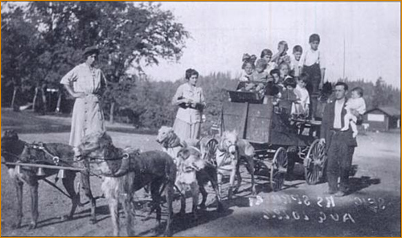 Seigler
Hot Springs: Dog Team Rides for Children Seigler Hot Springs:
Dog Team Rides for Children (Aug. 10, 1916) [6,
p. 63](click to enlarge) |
The
following description appears in the 1883 edition of Benjamin Truman's
Tourist's
Illustrated Guide to the Celebrated Summer and Winter Resorts:[
3]
|
Seigler Springs. — Situated in Lake County,
about two miles from Adam Springs, in an open, inviting
section of country. They consist of hot and cold sulphur,
soda, iron, arsenic and other waters, and have long
been recognized as possessing great healing properties;
and many cases of rheumatism, stiff joints, dropsy,
scrofula, skin diseases, gravel, diabetes, dyspepsia,
catarrh, chills and fever, lead poisoning, painter's
colic, constipation of the bowels, diseases of the
stomach and liver, Bright's disease of the kidneys,
and impurities of the blood, have either been cured
or relieved.
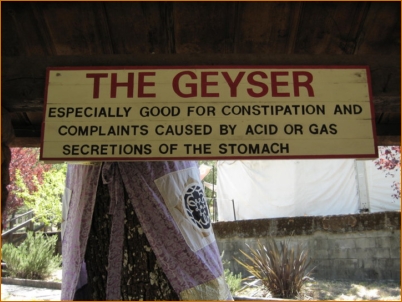
The Geyser: the original "Seigler Springs
Resort" sign is still there!
The Geyser: the original "Seigler Springs
Resort" sign is still there!
(click to enlarge) |
The hotel and cottages will accommodate
one hundred people.[7] Analyses
were made of these waters some years ago for Alvinza
Hayward, but they have been misplaced and cannot be
found.
ROUTE OF TRAVEL, ETC. — By rail
or ferry of the Central Pacific Railroad to Calistoga; thence by stage to the
springs, via either Glenbrook, 33 miles, or Lower Lake, a little further.
The Seigler Springs stage will connect with the stage from Calistoga at Lower
Lake on Monday, Wednesday, and Friday; at Glenbrook on Tuesday, Thursday, and
Saturday. Time from San Francisco, 12 hours. This place is kept open all the year
round, and is owned by John Spaulding, and managed by W. T. Garratt, whose address
is Seigler Springs, Lake County. There are hot sulphur and arsenic baths and a
hot swimming bath. There is good trout fishing near, and some game. |
We
still have a young woman’s account (written sometime in the late 19th century)
of her journey by stage coach to Seigler Springs.[4]
She departed from San Francisco in the early morning, and arrived at Seigler Springs
in the evening, after a twelve-hour trip. About her arrival, she writes:
It
has grown dark and the oil lights on either side of the stage have been lit. Fortunately
the horses know the road for such dim lights could scarcely serve to guide them.
We cannot see them at all for the air is cold and the canvas has been fastened
over the windows. . . And now at last, we are at Seigler Springs. In the darkness
we can see little but the outline of evergreen trees against the sky and a wide
veranda lit by hanging lanterns.
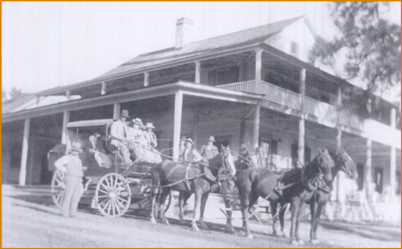 The
Seigler Hot Springs Hotel (with its own stage coach) The
Seigler Hot Springs Hotel (with its own stage coach) [6](click
to enlarge)The
proprietor comes out to greet us and we enter a spacious lobby. There is a stone
fire-place at one side with a small fire burning. We register at the desk and
then follow a maid carrying an oil lamp up the stairs. There is a long narrow
hall with many doors leading off into all directions. The rooms are nicely
furnished with heavy velvet drapes, solid wood furniture beautifully carved and
thick rugs. The maid puts our dusty outer garments on a dustsheet and carries
them away to the back of the building where they will be shaken. She returns with
pitchers of warm water. Each room has its own commode, so it is possible to wash
up in privacy. Some of the gentlemen have gone downstairs for a night-cap, but
the ladies find it enough to remove their high-button shoes and corsets and get
into bed. After the night air the rooms seem rather warm and close, but,
of course, no-one opens the windows. It is a well established scientific fact
that night air is harmful to the lungs. We turn over and go to sleep. |
Around
1890, stone mason Tom Henry Smith made significant stonework contributions to
the resort. He built the stone dining room (now Darshan Adytum) and the bath houses, and made other
stone improvements. The rock he used came from a hill between what is now the
Paul Hoberg Airport[19] and the Seigler Springs resort, and also from
a quarry just north of the resort.[10] Much of Smith's
elegant stonework is still very visible in the central part of the Mountain Of
Attention Sanctuary.
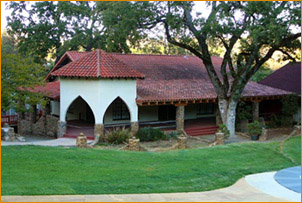
Smith's
elegant stonework is very visible in Darshan Adytum
Smith's
elegant stonework is very visible in Darshan Adytum
(click to enlarge) |
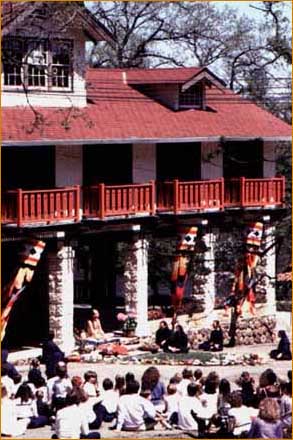
Smith's stonework again, in the front of Huge Helper
(formerly the resort hotel). In this 1982 photo, Adi
Da is sitting with devotees. |
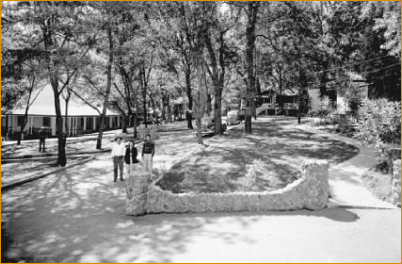 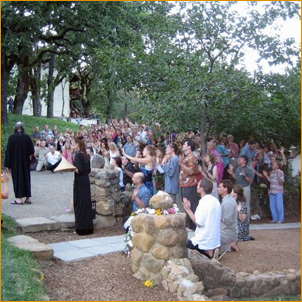
Here,
Smith's stonework gracefully lines some of the walks.
In this photo from the mid 1990's, Adi Da is walking
along some of those paths, from The Manner of Flowers
to Ordeal Bath Lodge.
Here,
Smith's stonework gracefully lines some of the walks.
In this photo from the mid 1990's, Adi Da is walking
along some of those paths, from The Manner of Flowers
to Ordeal Bath Lodge.
(click to enlarge)
|
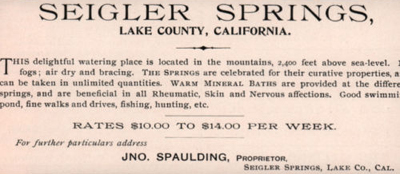
Newspaper
ad: 1899
Newspaper ad: 1899
(click to enlarge) |
Around the turn of the century, visiting a
resort like Seigler Springs was considered such a significant
social event that the names of resort visitors would appear
in the society columns of the major newspapers.
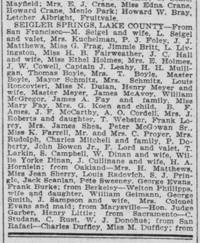 The
San Francisco Call, June 22, 1902 The San Francisco Call, June
22, 1902 [ 8] (click to enlarge) |
Celebrities, royalty, politicians, the wealthy, and often the ill, braved the
inconvenience and discomfort of the arduous trip over winding,
narrow mountain roads that were hardly more than trails,
riding in horse-drawn stage coaches that pitched and jolted
every foot of the way. After undergoing a day or two of
this inconvenience to arrive at their destination, the travelers
were happy to remain at the resort for weeks on end. They
often returned year after year for a season at their favorite
resort.[22]
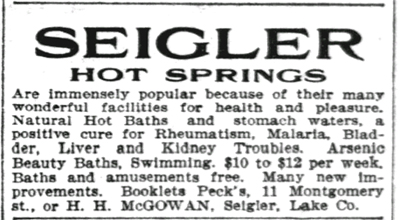
Newspaper
ad: 1905
Newspaper ad: 1905
(click to enlarge) |
The Great Earthquake of 1906
Around 1906, most of the hot springs in Northern California underwent major geothermal changes. It is believed that the great earthquake of 1906 (which resulted in the destruction of much of San Francisco) caused many of the hot springs (but not Seigler Springs) to stop, slow down, or go underground, diminishing their ability to continue serving as the core of a hot springs resort. As a result, tourism in Lake County declined.
Rehabilitation
By 1930, even though its hot springs were still geothermally active, Seigler Springs had gotten somewhat
run down as an establishment, and attracted fewer guests. Noting this, the Hoberg
brothers (George, Paul and Frank) — who ran the nearby Hoberg's
Resort in Cobb — together with Norwegian sea captain
Gudmund "Midnight" Olsen (who had just retired
from a storied career on the Pacific coastal waters), and Olsen's son and daughter-in-law
Ernest and Dorothy Olsen, purchased Seigler Springs [6,
p.79].
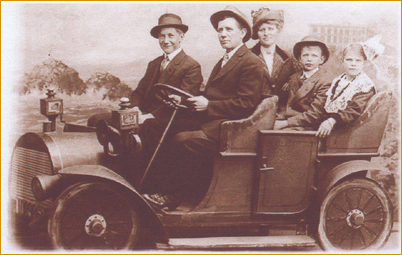
Captain
Gudmund "Midnight" Olsen "at the
wheel", with his family, in 1912, a couple
of decades before he retired from the sea and helped
save Seigler Springs. His son Ernest is in the back seat.
Captain
Gudmund "Midnight" Olsen "at the wheel",
with his family, in 1912, a couple of decades before
he retired from the sea and helped save Seigler Springs.
His son Ernest
is in the back seat.
(click to enlarge) |
The combined efforts of the Hobergs and the
Olsens (and, from 1948, the Olsens alone, after
the Olsens bought the Hobergs' share of the ownership) rehabilitated
and modernized the old mineral springs resort, adding new
bath houses and cabins, a sewer system, and new foundations
to replace old ones, along with other renovations.[9]
The resort could now accommodate up to 400 people.
As a result of all these renovations, the resort became successful again, to the
point where it was oversubscribed and turning away guests
annually.[5] It re-attained its early day fame as "the leading Mineral
Spring and Pleasure Resort in California".

The
above cabin (now the corner cabin on "the Circle")
was named "S.S. Acme" (see the sign above the door), in honor of Captain
Gudmund "Midnight" Olsen, co-owner of
the resort. (The "Acme" was one of the
lumber steam schooners Olsen had skippered.) Olsen
and his wife spent their summer months at the resort.
The
above cabin (now the corner cabin on "the Circle")
was named "S.S. Acme" (see the sign above the door), in honor of Captain
Gudmund "Midnight" Olsen, co-owner of the
resort. (The
"Acme" was one of the lumber steam schooners
Olsen had skippered.) Olsen
and his wife spent their summer months at the resort.
(click to enlarge) |
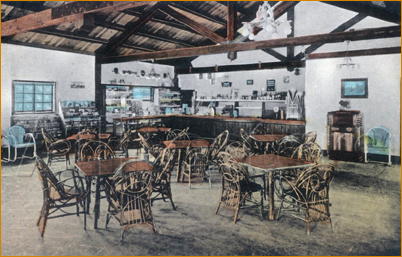
Seigler Hot Springs Store / Post
Office (now Darshan Adytum, formerly Great Food Dish) with a coffee shop
and soda fountain. The room also included a pool table and a jukebox.
In the basement was the unique "Stone Cellar Lounge", created by stone mason Tom Henry Smith, who crafted so much of the stonework on the property.
Seigler Hot Springs Store / Post
Office (now Darshan Adytum, formerly Great Food Dish) with a coffee shop
and soda fountain. The room also included a pool table and a jukebox.
In the basement was the unique "Stone Cellar Lounge",
created by stone mason Tom Henry Smith, who crafted
so much of the stonework on the property. (click
to enlarge) |
Over the years, Seigler Springs was enlarged
from the original hotel, to additionally include a dining
room, twenty-five cottages, a barber shop, a post office,
a "solarium" (for the ladies), a "bachelor hall" (for the men),
a dance hall (for the ladies and the men to get together), tennis, badminton, and shuffleboard courts, elaborate Roman Baths, an all tile hot indoor plunge, a tile swimming pool, a children's pool, and a native stone cocktail lounge and bar. By the 1950's, a professional
chef and a group of cooks were providing three gourmet meals
a day [6, p.78]. Sunbathers on the lawns were serenaded
by a strolling accordion player,[6] and the resort had
live dance music nightly.
Seigler Springs also had a "party boat" available
for excursions on Clear Lake on the weekends, as well as
occasional "swimming suit beauty contests".
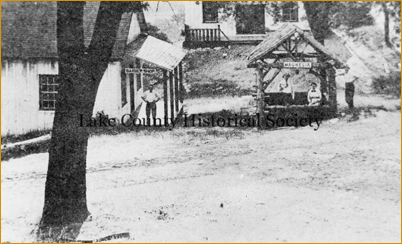
barber
shop at Seigler Springs
photo copyright Lake County Historical Society
barber
shop at Seigler Springs
photo copyright Lake County Historical Society
(click to enlarge) |
 Seigler
Hot Springs indoor pool (1952) Seigler Hot Springs indoor pool
(1952) [ 6, p.74] [now the "plunge" in Ordeal
Bath Lodge] The water was naturally heated spring water (click
to enlarge) |
Past the Peak
Seigler Springs remained a popular resort
until about 1967.[2] But by that
time, the heyday of the Lake County hot springs resorts had passed. Several reasons have been suggested. Less trust
in the health claims of mineral waters;
new highways halving the driving time from the Bay area to
Lake Tahoe; the advent of RV's; commercial flights to Hawaii;
a changing concept of "vacation" — all of these had
an impact. Many other resorts had either been destroyed
by fire,[20] or were not able
to financially survive. By 1967, Seigler Springs
was struggling as well.
| Attempting to salvage the resort, Ernest and Dorothy
Olsen turned it into a Boys Athletic Camp in 1967, under
the direction of their son-in-law, Bill Hecomovich.[21]
Each summer, hundreds of high school athletes would
come to attend sessions at the "Sports Camp",
which included a football camp and a wrestling camp
(among others). The football camp became known for its
disciplining of its athletes. It was described as "a
cross between a Marine Boot Camp and a Pro-Football
Camp". The daily discipline included uphill runs (called
"run to gut rock") and nearly four mile morning runs
up and down the hilly countryside. |

Bill Hecomovich |

The
"Seigler Springs Sports Camp" (1967-1972)
photo copyright Lake County Historical Society
The
"Seigler Springs Sports Camp" (1967-1972)
photo copyright Lake County Historical Society
(click to enlarge) |
But the "Seigler Springs Sports Camp"
would only last for five years.
A Spiritual Destiny
Seigler Springs had a different
destiny. . . albeit one that would resonate with and build upon all three of its earlier purposes:
the sacred use made by the Pomo Indians (which included the development of "holy sites" like the current Holy Cat Grotto); the "resort" focus on sanctuary and wellness; and the discipline and self-transcendence of the "sports camp".
The 1960's had introduced Eastern spirituality into
the West on a massive scale. One consequence of this new and growing interest
among Westerners was that, in the early 1970's, many new spiritual groups were
looking for a secluded place where they could start a spiritual community comprised
of Westerners. In some sense, the hot springs resorts of Northern California and
these new spiritual communities were a natural match — not only because of the
remoteness of their locale, but because the facilities on the premises (from communal
dining rooms, to lodgings, to meeting centers) were already oriented toward
"community life" (of a sort), and were time-tested (by thousands of
visitors) and well-developed. One of the best known transformations of this kind
was the sale of Hoberg's Resort. A celebrity resort in its time, Hoberg's sported entertainment
by big band notables like Tommy Dorsey and Harry James, and attracted celebrity
guests from Lillie Langtry early in the twentieth century, to Clark Gable and Jackie Gleason decades later. In 1974, Hoberg's would be transformed into Maharishi Mahesh Yogi's "Maharishi International
University". A new sign posted on the main road read, "The Capital
of the Age of Enlightenment of Northern California".[17]
(The Maharishi's organization continued to own the property through July, 2010.[16])
In
a similar manner, the Heart Consciousness Church purchased Harbin
Hot Springs (about 20 miles from the Mountain Of Attention), and adapted it
into a "New Age" retreat and workshop center that also met its own communal needs.
| Down on its own fortunes, the "Seigler Springs Sports
Camp" followed suit in 1972, and was sold to the organization
of Swami Satchidananda (founder of Integral Yoga). For
a brief time, it became what Swami Satchidananda called
"Yogaville West". Swami Satchidananda's intention
was to create a "Yoga village" where "seekers
would live together practicing the Yogic teachings,
a large community where they could grow their food,
educate their children and create an economy based on
yogic values and high ideals."[13] |

Swami
Satchidananda |
Acclaimed guitarist John
Fahey included a pamphlet about Yogaville West in an album he released at the
time. The pamphlet included the following invitation: "I would like to introduce
you to this healthy, spiritually based concept of living. The 46 people living
here follow the ideals of Integral Yoga as taught by Swami Satchidananda. To the
extent that I have practised these techniques, they really seem to work."
As
it turned out, this particular experiment would only last a couple of years. In
considering later why it didn't work out, the Yogaville Journal included
this exchange:[11]
GM:
. . . I feel it greatly increases the stability of an organization to be integrated
with the community in which it is located. The more integrated the better. Other
ashrams — where all the people came in from other places — well, those ashrams
no longer exist! VV: You’re right. In fact, that is one of the reasons the
original Yogaville West at Seigler Springs failed. The community around saw us
as outsiders — a bunch of hippies — and made it difficult for us to make a go
of it there.[15] |
It
was also difficult to survive financially at the time, according to Swami Karunananda:[12]
At
the time, I was living at Yogaville West in Lake County, California. Those were
the “pioneer days” of the IYI [Integral Yoga Institute]. We had little in the
way of financial resources and lived very frugally. The room I occupied was in
a solitary location; I rarely had visitors. |
And so, for a variety of reasons, Yogaville West did not work out, and Seigler Springs was placed on the market again.
Adi Da's Empowered Sanctuary
By 1973, Avatar Adi Da Samraj also was looking for a more
secluded place where He could continue His already ongoing
work with devotees, which was rapidly outstripping what
the La Brea Avenue Ashram could provide. Having the Ashram
in the middle of Los Angeles simply was no longer sufficient,
and the urban environment (and its associated psyche) was
not a good match with Adi Da's intentions for the Ashram.
So Adi Da asked His devotees to look for a more appropriate,
rural place — and they found that Seigler Springs was available.
They showed Adi Da pictures of the Seigler Springs property.
He made the decision (on October 25, 1973) to acquire the property based solely on looking at the pictures, without having travelled to visit the place.
Adidam purchased the property, with the help of a generous donation from devotee
Dennis Duff (story
here), and prepared the place for use by Adi Da as His
Ashram. Adi Da took up residence there on January 23, 1974.
He gave His first talk at the new Sanctuary — "Better
To Be Happy Than Concerned" — on January 26, 1974,
in Temple Eleutherios.
The
resort buildings had been abandoned for that purpose decades before our arrival.
All the old wooden buildings had fallen into disrepair, and that is how we found
them. It was a real fixer-upper, a ghost town to boot. Toni
Vidor |
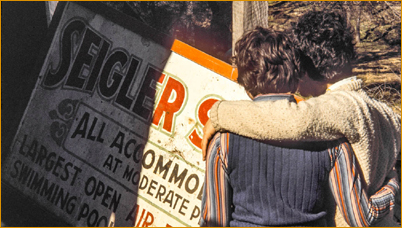
When
devotees arrived, they found "a real fixer-upper,
a ghost town to boot."
When
devotees arrived, they found "a real fixer-upper,
a ghost town to boot."
(click to enlarge) |
To anyone who has visited the Mountain
Of Attention, the primary thing one will notice (in comparing it to the historical
photographs of Seigler Hot Springs on this page) is how utterly Adi Da has transformed
the energy, the feeling, and even the look of the place — not only through many
new buildings and holy sites, but through re-architecting the landscape of the
property — completely conforming it to His Divine purposes.[18]
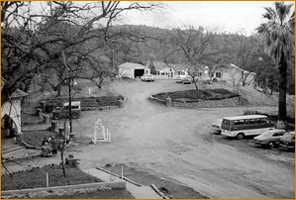 The
Mountain Of Attention, 1974 |  The
Mountain Of Attention, 2010 |
1974
vs. 2010: About the only thing still recognizable is the 1974 structure of stone
walls and an opening between them, that would later be replaced by Seventh Gate.
(A bit of Darshan Adytum can also be seen off to the left in the 1974 photo.)
(click
pictures to enlarge) |
Vestiges of the original hot springs still do remain, in places like Ordeal Bath Lodge, Lithia
Springs, and Holy Cat Grotto. The property remains a place of healing
—
not because of the medicinal qualities of its waters, but because of its Divine
Transmission. (For just one healing story out of many, read A Touch of the Divine: A Miraculous Healing at Ordeal Bath Lodge.) It continues to be a place where people leave conventional life
behind. . . now not as vacationers, but as practitioners of a profound, self-transcending
spiritual practice, the Way of Adidam.
 Seigler
Hot Springs: More Historical Photos
Seigler
Hot Springs: More Historical Photos 
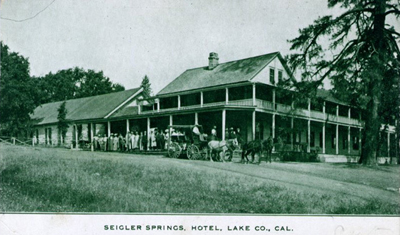 Seigler
Hot Springs Hotel (1910) Seigler Hot Springs Hotel (1910)
On the
left is the dining hall, which is now Temple Adi Da. (click
to enlarge) |
 Seigler
Hot Springs Hotel (1910) Seigler Hot Springs Hotel (1910) with
its own stage coach (which connected with travellers at Lower Lake). On the
left is the dining hall, which is now Temple Adi Da. |
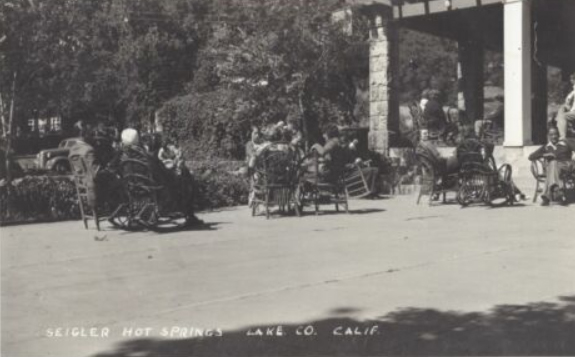
Guests relaxing off one end of
the front porch of Seigler
Hot Springs Hotel (1910) |
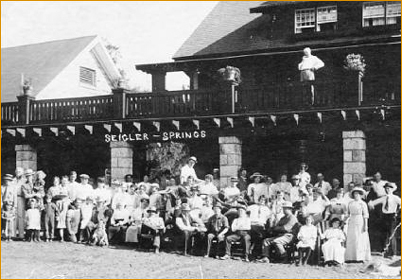
Seigler
Hot Springs Hotel (prior to 1920).
The resort guests are posing for a photograph in
front of the hotel.
Seigler Hot Springs Hotel (prior to 1920).
The resort guests are posing for a photograph in front
of the hotel.
(click to enlarge) |
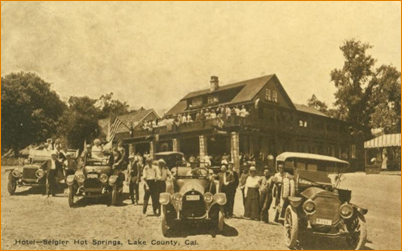
Seigler
Hot Springs Hotel (around 1920)
S eigler
Hot Springs Hotel (around 1920)
(click to enlarge) |
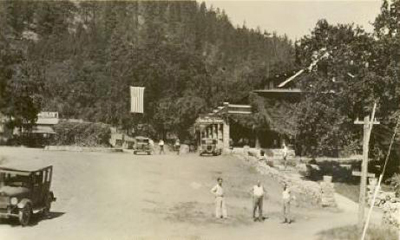 Seigler
Hot Springs Hotel (the car makes suggest it was the 1920's) Seigler Hot Springs
Hotel (the car makes suggest it was the 1920's) Business is booming, and the front area
has been converted from grass to parking lot. (click
to enlarge) |
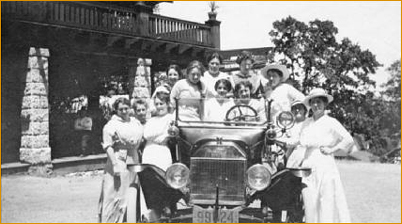
Seigler
Hot Springs Hotel, with a carload of ladies out
front.
S eigler
Hot Springs Hotel, with a carload of ladies out front.
(click to enlarge) |
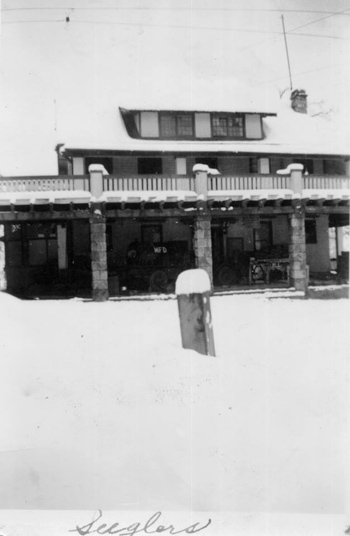
Seigler
Hot Springs Hotel (1937)
Seigler Hot Springs Hotel (1937)
covered in snow
(click to enlarge) |
 Seigler
Hot Springs Hotel (1930's or 1940's?) Seigler Hot Springs Hotel
(1930's or 1940's?) side view, in the spring (click
to enlarge) |

The
Seigler Hot Springs Hotel: circa 1940
The Seigler Hot Springs Hotel: circa 1940
(click to enlarge) |
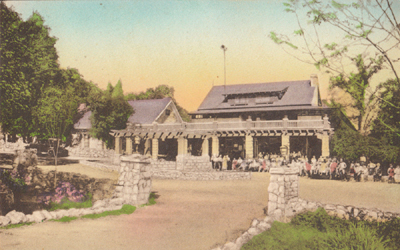
The
Seigler Hot Springs Hotel: circa 1940
The Seigler Hot Springs Hotel: circa 1940
(click to enlarge) |
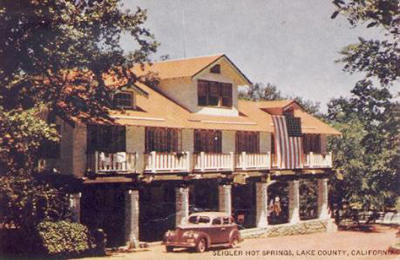 Seigler
Hot Springs Hotel (1940's) Seigler Hot Springs Hotel (1940's) (click
to enlarge) |
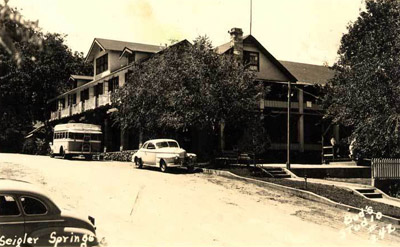 Seigler
Hot Springs Hotel (1940's) Seigler Hot Springs Hotel (1940's) with
a tourist charter bus out front (click to enlarge) |
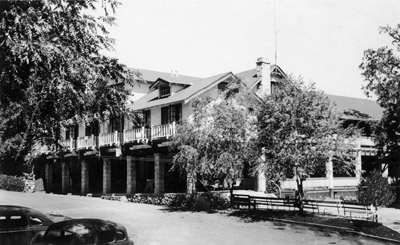 The
Seigler Hot Springs Hotel (1940's) The Seigler Hot Springs Hotel
(1940's) (click to enlarge) |
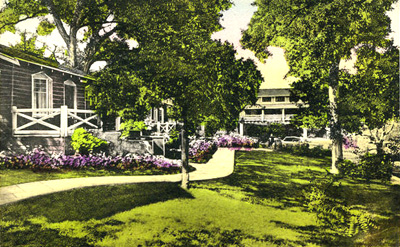
The
Seigler Hot Springs Hotel and Cottages: 1942
The Seigler Hot Springs Hotel and Cottages: 1942
(click to enlarge) |
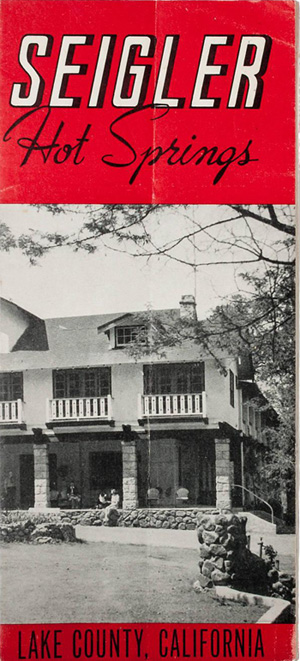
resort
pamphlet (1950's)
resort
pamphlet (1950's)
(click to enlarge) |
|
Seigler
Springs matchbook
Seigler
Springs matchbook
(click to enlarge)
|

Seigler
Springs matchbook
Seigler
Springs matchbook
(click to enlarge) |
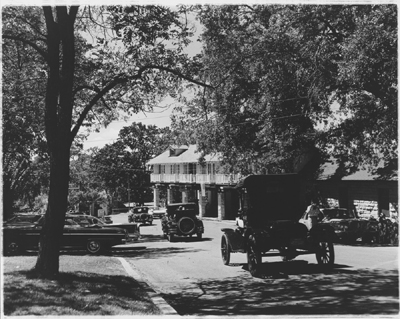
The
Seigler Hot Springs Hotel (1962) with cars of the
1910's and 1920's alongside the latest 1962 models
The Seigler Hot Springs Hotel (1962)
with cars of the 1910's and 1920's
alongside the latest 1962 models
(click to enlarge) |
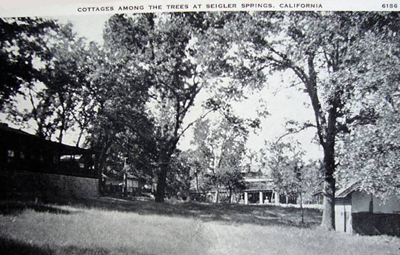 Cottages at Seigler Hot Springs
(1915 - 1920)
[The large cottage now known as "The Oaks" is to the
left;
Huge Helper ("the hotel") is straight ahead.]
Cottages at Seigler Hot Springs
(1915 - 1920) [The large cottage now known as "The Oaks" is to the
left; Huge Helper ("the hotel") is straight ahead.] (click
to enlarge) |

Cottages
at Seigler Hot Springs
Cottages at Seigler Hot Springs |
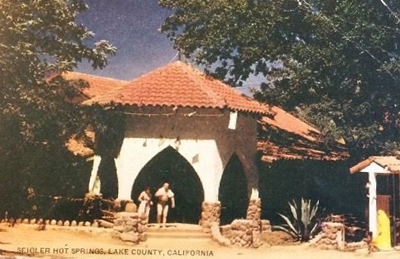
Bathers
leaving the building now known as Darshan Adytum:
1964
Bathers leaving the building now known as Darshan
Adytum: 1964
(click to enlarge) |
 Seigler
Hot Springs lodgings (now known as "Goat's Wool") Seigler
Hot Springs lodgings (now known as "Goat's Wool") (click
to enlarge) |
 Seigler
Hot Springs Swimming Pool (1913) Seigler Hot Springs Swimming
Pool (1913) [The swimming pool is located next to Holy
Cat Grotto] (click to enlarge) |
 Seigler
Hot Springs Swimming Pool (1915) Seigler Hot Springs Swimming
Pool (1915) (click to enlarge) |
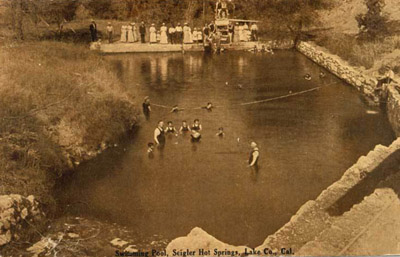 Seigler
Hot Springs Swimming Pool (1917) Seigler Hot Springs Swimming
Pool (1917) (click to enlarge) |
 Seigler
Hot Springs Swimming Pool (year?) Seigler Hot Springs Swimming
Pool (year?) (click to enlarge) |
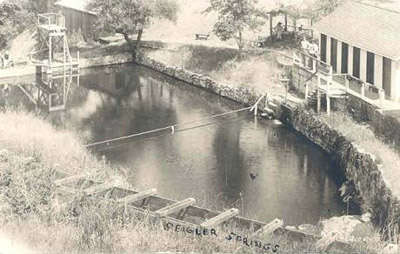 Seigler
Hot Springs Swimming Pool (year?) Seigler Hot Springs Swimming
Pool (year?) (click to enlarge) |

Seigler
Hot Springs Swimming Pool (1920's)
Seigler Hot Springs Swimming Pool (1920's)
(click to enlarge) |
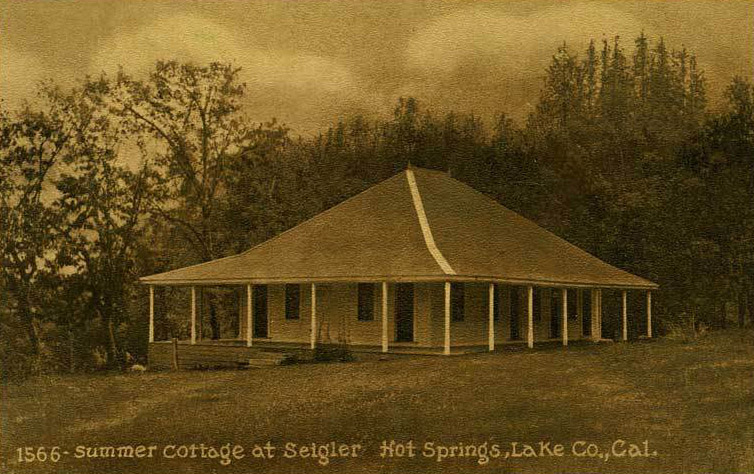 Seigler
Hot Springs summer cottage (1916) Seigler Hot Springs summer cottage
(1916) (click to enlarge) |
 Seigler Hot Springs
"Roman Baths" (1930's)
now known as Ordeal Bath Lodge
[The sign
reads: "Roman Baths - Hot Iron"
because the water was heated and
was rich in iron]
Seigler Hot Springs
"Roman Baths" (1930's) now known as Ordeal Bath Lodge[The sign
reads: "Roman Baths - Hot Iron" because the water was heated and
was rich in iron] (click to enlarge) |
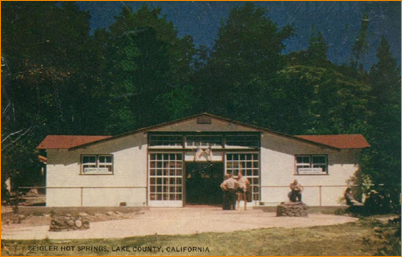
Seigler Hot Springs "Roman Baths" (1930's)
now known as Ordeal
Bath Lodge
(click to enlarge) |


186,104 people have liked our site's pages and shared them with their Facebook friends - Most Shared Pages
Bruce H. - Sebastopol, California, United States
(Sent Thursday, January 19, 2023 2:58AM)
Danyelle B. - Las Vegas, Nevada, United States
(Sent Thursday, January 19, 2023 2:08AM)
Rob D. - Massachusetts, United States
(Sent Friday, January 24, 2020 7:37PM)
David R. - Cobb, California, United States
(Sent Friday, January 24, 2020 6:22PM)
Alex J. - Middletown, California, United States
(Sent Friday, January 24, 2020 2:33PM)
Jackie F. - Richmond, Virginia, United States
(Sent Saturday, August 17, 2019 6:47PM)
Bonnie H. - Roseburg, Oregon, United States
(Sent Thursday, August 15, 2019 7:39AM)
Virginia H.
(Sent Thursday, August 15, 2019 4:17AM)
Frank Marrero - Maria Hoop, Netherlands
(Sent Sunday, July 16, 2017 7:29AM)
John B. - United States
(Sent Saturday, July 15, 2017 11:19PM)
Julie S. - Fairbanks, Alaska, United States
(Sent Saturday, July 15, 2017 11:12PM)
Phil S. - New Mexico, United States
(Sent Saturday, July 15, 2017 11:08PM)
James Bouryiotis - Belleville, Ontario, Canada
(Sent Saturday, July 15, 2017 9:38PM)
Ginger B. - Meiners Oaks, California, United States
(Sent Sunday, January 29, 2017 4:50AM)
sage one - sebastopol, California, United States
(Sent Monday, January 23, 2017 4:10AM)
Owen Rubin - Oakland, CA, United States
(Sent Saturday, March 12, 2016 2:18PM)
Linda B. - Middletown, Ohio, United States
(Sent Monday, December 14, 2015 10:31AM)
JoLynn S. - United States
(Sent Sunday, December 13, 2015 5:37PM)
Rob D. - Massachusetts, United States
(Sent Sunday, December 13, 2015 5:26PM)
Mara G. - Gardner, Colorado, United States
(Sent Sunday, December 13, 2015 5:24PM)
Chandira H. - United States
(Sent Sunday, December 13, 2015 11:05AM)
© 2024 Copyrighted materials used with the permission of The Avataric Samrajya of Adidam Pty Ltd, as trustee for The Avataric Samrajya of Adidam. All rights reserved. None of these materials may be disseminated or otherwise used for any non-personal purpose without the prior agreement of the copyright owner. ADIDAM is a trademark of The Avataric Samrajya of Adidam Pty Ltd, as Trustee for the Avataric Samrajya of Adidam.
Technical problems with our site? Let our webmaster know.